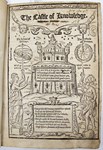Although catalogued as Ming style, the large gilt-bronze figure of a Luohan was thought to be from the late Song or Yuan period.
Estimated at $10,000-20,000 on October 20, it hammered at $750,000 ($937,500 including 25% buyer’s premium).
As Buddha’s apostles, Luohan were depicted in Chinese art from the Tang dynasty onwards. This figure measuring 2ft 7in (79cm) high is shown seated in Padmasana, wearing a Han-style monk’s robe. The right hand symbolises the dispelling of sickness or negative thoughts. The left hand with the palm held up signifies the act of teaching or reassurance. The character mark on the overhanging robe, possibly indicates the order of placement within a temple.
Song dynasty
The superb casting and style of this figure is very similar to a few recorded examples that have been dated to the end of the Song dynasty (960-1279) and the Mongol-led Yuan state that lasted from 1271-1368. Similar sculptures of the period were also made in ceramic and wood.
This bronze is closely related to one sold at Christie’s twice in living memory: first in New York in 2001 (before the Chinese market ‘boom’) where it took $112,500 and then in Hong Kong in 2016 when its value had spiralled to HK$34,14m (close to $4m).
As they share similar animated gestures, quality of portraiture and the treatment of the fluid folds of drapery, it is possible that they may have come from the same set.
DuMouchelles’ sculpture came from the estate of Barbara Jean and Kerry Nicholl of Harrison Township, Michigan.
A detailed video showed its fine condition (the right index finger was detached and a tip to left little finger was missing) and the crisp modelling.
The auction house concluded it was “a very high-quality bronze whose age could be older than the description indicates”.















